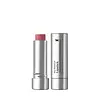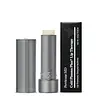What's inside
What's inside
 Key Ingredients
Key Ingredients

 Benefits
Benefits

 Concerns
Concerns

 Ingredients Side-by-side
Ingredients Side-by-side

Zinc Oxide 7.5%
Cosmetic ColorantPolyglyceryl-2 Diisostearate
EmulsifyingPolyethylene
AbrasiveSimmondsia Chinensis Seed Oil
EmollientTridecyl Trimellitate
EmollientOctyldodecanol
EmollientHydrogenated Jojoba Oil
AbrasiveSynthetic Wax
AbrasiveMango Butter Dimer Dilinoleyl Esters/Dimer Dilinoleate Copolymer
EmollientVp/Eicosene Copolymer
Ethylhexyl Palmitate
EmollientSilica
AbrasiveBeeswax
Emulsion StabilisingC10-30 Cholesterol/Lanosterol Esters
EmulsifyingOzokerite
Emulsion StabilisingVp/Hexadecene Copolymer
Butylene/Ethylene/Styrene Copolymer
Ethylene/Propylene/Styrene Copolymer
Vanillin
MaskingPalmitoyl Tripeptide-1
Skin ConditioningTocopheryl Acetate
AntioxidantArgania Spinosa Kernel Oil
EmollientVegetable Oil
Skin ConditioningBisabolol
MaskingSodium Hyaluronate
HumectantBHT
AntioxidantIsostearic Acid
CleansingGlyceryl Isostearate
EmollientIsopropyl Titanium Triisostearate
EmollientPolyhydroxystearic Acid
EmulsifyingTribehenin
EmollientSilica Dimethyl Silylate
EmollientSorbitan Isostearate
EmulsifyingButylene Glycol
HumectantPentylene Glycol
Skin ConditioningCI 77891
Cosmetic ColorantCI 15850
Cosmetic ColorantIron Oxides
CI 17200
Cosmetic ColorantCI 19140
Cosmetic ColorantCI 45410
Cosmetic ColorantCI 42090
Cosmetic ColorantZinc Oxide 7.5%, Polyglyceryl-2 Diisostearate, Polyethylene, Simmondsia Chinensis Seed Oil, Tridecyl Trimellitate, Octyldodecanol, Hydrogenated Jojoba Oil, Synthetic Wax, Mango Butter Dimer Dilinoleyl Esters/Dimer Dilinoleate Copolymer, Vp/Eicosene Copolymer, Ethylhexyl Palmitate, Silica, Beeswax, C10-30 Cholesterol/Lanosterol Esters, Ozokerite, Vp/Hexadecene Copolymer, Butylene/Ethylene/Styrene Copolymer, Ethylene/Propylene/Styrene Copolymer, Vanillin, Palmitoyl Tripeptide-1, Tocopheryl Acetate, Argania Spinosa Kernel Oil, Vegetable Oil, Bisabolol, Sodium Hyaluronate, BHT, Isostearic Acid, Glyceryl Isostearate, Isopropyl Titanium Triisostearate, Polyhydroxystearic Acid, Tribehenin, Silica Dimethyl Silylate, Sorbitan Isostearate, Butylene Glycol, Pentylene Glycol, CI 77891, CI 15850, Iron Oxides, CI 17200, CI 19140, CI 45410, CI 42090
Cocos Nucifera Oil
MaskingBeeswax
Emulsion StabilisingSimmondsia Chinensis Seed Oil
EmollientRicinus Communis Seed Oil
MaskingHelianthus Annuus Seed Oil
EmollientPolyethylene
AbrasivePolyhydroxystearic Acid
EmulsifyingAcrylates Copolymer
Ethylhexyl Palmitate
EmollientVanillin
MaskingArgania Spinosa Kernel Oil
EmollientAstrocaryum Murumuru Seed Butter
EmollientButyrospermum Parkii Butter
Skin ConditioningOryza Sativa Bran Extract
Skin Conditioning1,2-Hexanediol
Skin ConditioningCaprylyl Glycol
EmollientPhosphatidylcholine
EmulsifyingTocopherol
AntioxidantGlycine Soja Oil
EmollientTribehenin
EmollientRosmarinus Officinalis Leaf Extract
AntimicrobialOctyldodecanol
EmollientSorbitan Isostearate
EmulsifyingHelianthus Annuus Extract
EmollientSilica Dimethyl Silylate
EmollientQuaternium-90 Bentonite
Butylene Glycol
HumectantPentylene Glycol
Skin ConditioningLactic Acid
BufferingMethyl Nicotinate
SoothingPropylene Carbonate
SolventSodium Hyaluronate
HumectantPalmitoyl Tripeptide-1
Skin ConditioningCaffeine
Skin ConditioningNiacin
SmoothingAscorbyl Palmitate
AntioxidantCitric Acid
BufferingCocos Nucifera Oil, Beeswax, Simmondsia Chinensis Seed Oil, Ricinus Communis Seed Oil, Helianthus Annuus Seed Oil, Polyethylene, Polyhydroxystearic Acid, Acrylates Copolymer, Ethylhexyl Palmitate, Vanillin, Argania Spinosa Kernel Oil, Astrocaryum Murumuru Seed Butter, Butyrospermum Parkii Butter, Oryza Sativa Bran Extract, 1,2-Hexanediol, Caprylyl Glycol, Phosphatidylcholine, Tocopherol, Glycine Soja Oil, Tribehenin, Rosmarinus Officinalis Leaf Extract, Octyldodecanol, Sorbitan Isostearate, Helianthus Annuus Extract, Silica Dimethyl Silylate, Quaternium-90 Bentonite, Butylene Glycol, Pentylene Glycol, Lactic Acid, Methyl Nicotinate, Propylene Carbonate, Sodium Hyaluronate, Palmitoyl Tripeptide-1, Caffeine, Niacin, Ascorbyl Palmitate, Citric Acid
Ingredients Explained
These ingredients are found in both products.
Ingredients higher up in an ingredient list are typically present in a larger amount.
You may know this ingredient as argan oil. Argan Oil has antioxidant, hydrating, and soothing properties.
Studies have shown argan oil can help fight again radical damage from the sun. This makes it effective at preventing hyperpigmentation.
Large amounts of vitamin E found in argan oil helps the skin retain water. Argan oil also contains fatty acids such as linoleic acid, oleic acid, and palmitic acid. It is also a good source of lipids.
Another benefit of argan oil is skin-soothing. It can help reduce inflammation-related skin symptoms.
Argan Oil is effective at regulating sebum production in pores. This can make it effective at treating hormonal acne.
Traditionally, argan oil was used for its antibacterial and antifungal properties. However, argan oil contains fatty acids that may make it not fungal-acne safe.
Argan Trees are native to Morocco.
Learn more about Argania Spinosa Kernel OilBeeswax is natural wax produced by honey bees and can be synthetically created. It consists mainly of fatty acid esters and long-chain alcohols.
In cosmetics, beeswax is a emollient. Due to its waxy structure, it creates a protective barrier. This barrier prevents water from evaporating off the skin.
This may not be a good ingredient for oily skin. We recommend speaking with a professional if you have concerns.
Beeswax cannot be removed with water, but can be taken off with an oil cleanser.
Beeswax is also antiseptic and contains vitamin A.
Learn more about BeeswaxButylene Glycol (or BG) is used within cosmetic products for a few different reasons:
Overall, Butylene Glycol is a safe and well-rounded ingredient that works well with other ingredients.
Though this ingredient works well with most skin types, some people with sensitive skin may experience a reaction such as allergic rashes, closed comedones, or itchiness.
Learn more about Butylene GlycolEthylhexyl Palmitate, also known as octyl palmitate, is created from 2-ethylhexyl alcohol and palmitic acid. It is a fatty acid ester.
The fatty acid content of Ethylhexyl Palmitate makes it an emollient. Emollients help soften and hydrate your skin by trapping moisture within.
Ethylhexyl Palmitate is also used to help improve the texture of cosmetics. It helps other ingredient dissolve in products and help disperse ingredients more evenly.
You'll likely find this ingredient in sunscreen, as it is often used to mix UV-blocking ingredients such as avobenzone and ethylhexyl triazone.
It can also help stabilize the fragrances in a product as a fragrance fixative.
Ethylhexyl Palmitate can be used to substitute mineral oil.
Due to its high fatty acid content, it may not be fungal-acne safe.
Learn more about Ethylhexyl PalmitateOctyldodecanol is a fatty alcohol. It is primarily used to enhance the texture of products.
As an emulsifier, Octyldodecanol helps prevent the oils and waters from separating. It also prevents ingredients from creating foam when shaken.
Octyldodecanol is created by reducing fatty acid to an alcohol.
Due to its high molecular weight, it does not get absorbed into the skin.
Learn more about OctyldodecanolPalmitoyl Tripeptide-1 is also known as pal-GHK. It is made up of 3 amino acids and palmitic acid, a fatty acid that helps it absorb into skin more easily.
This peptide is as a signal peptide, meaning it tells the skin to produce more collagen. Collagen is the key protein that helps form the skin's structure and keep it plump, firm, and hydrated.
By boosting collagen production, this ingredient supports a stronger skin barrier and helps reduce the appearance of wrinkles.
You'll most likely see this ingredient paired with Palmitoyl Tetrapeptide-7 in the well-known Matrixyl 3000 complex. While results from in-house testing should be viewed cautiously, this peptide duo is among the most studied and widely used in modern skincare.
Due to its palmitic acid base, this ingredient may not be safe for Malassezia folliculitis.
Read more about other common types of peptides here:
Learn more about Palmitoyl Tripeptide-1Pentylene glycol is typically used within a product to thicken it. It also adds a smooth, soft, and moisturizing feel to the product. It is naturally found in plants such as sugar beets.
The hydrophilic trait of Pentylene Glycol makes it a humectant. As a humectant, Pentylene Glycol helps draw moisture from the air to your skin. This can help keep your skin hydrated.
This property also makes Pentylene Glycol a great texture enhancer. It can also help thicken or stabilize a product.
Pentylene Glycol also acts as a mild preservative and helps to keep a product microbe-free.
Some people may experience mild eye and skin irritation from Pentylene Glycol. We always recommend speaking with a professional about using this ingredient in your routine.
Pentylene Glycol has a low molecular weight and is part of the 1,2-glycol family.
Learn more about Pentylene GlycolPolyethylene is a synthetic ingredient that helps the skin retain moisture. It is a polymer.
It is also typically used within product formulations to help bind solid ingredients together and thicken oil-based ingredients. When added to balms and emulsions, it helps increase the melting point temperature.
Polyhydroxystearic Acid is a soft wax made from castor oil.
It is is a texture thickener, emulsifier, and film-former. Emulsifiers prevent ingredients from separating, such as oils and waters.
Polyhydroxystearic Acid may not be fungal acne safe.
Learn more about Polyhydroxystearic AcidThis silica is mainly used to thicken oils and suspend particles in oils. It is not water soluble.
According to the manufacturer, it:
The manufacturer also claims this ingredient to be useful in makeup.
In lipstick formulations, this ingredient improves color payoff, reduces pigment settling, and reduces oil bleeding. This ingredient also improves the grip of powder products such as dry shampoos.
Learn more about Silica Dimethyl SilylateThis oil comes from the seeds of the desert shrub called Jojoba. It is more commonly known as jojoba oil, a non-comedogenic oil.
Jojoba oil does not contain fragrance and has many fatty-acids, making it a great soothing ingredient.
It also contains Vitamin E, a great moisturizing ingredient. Vitamin E is also an antioxidant and protects your skin against oxidative damage.
This ingredient humectant properties, meaning it helps draw moisture from the air. This helps keep your skin hydrated.
While jojoba has antibacterial properties, it is only able to kill some strains of bacteria.
Studies also show it helps in wound healing. In fact, Indigenous cultures have used jojoba as a moisturizer and to help treat burns for centuries.
Fun fact: Jojoba oil similar to natural human skin sebum, so it has a great effect on dry skin. It is also promising with helping to regulate sebum production.
Due to its fatty acid content, Jojoba oil may not be fungal acne safe. We recommend speaking with a professional if you have any concerns.
Learn more about Simmondsia Chinensis Seed OilSodium Hyaluronate is hyaluronic acid's salt form. It is commonly derived from the sodium salt of hyaluronic acid.
Like hyaluronic acid, it is great at holding water and acts as a humectant. This makes it a great skin hydrating ingredient.
Sodium Hyaluronate is naturally occurring in our bodies and is mostly found in eye fluid and joints.
These are some other common types of Hyaluronic Acid:
Learn more about Sodium HyaluronateSorbitan Isostearate is an emulsifer and cleaning agent. It is created from isostearic acid and sorbitol.
As an emulsifier, Sorbitan Isostearate prevents oils and water from separating.
Due to its isostearic acid base, it may not be safe for Malassezia or fungal acne.
Learn more about Sorbitan IsostearateTribehenin comes from glycerin and behenic acid.
It is used as an emollient, or moisturizer. Emollients form a thin barrier on skin to prevent moisture from escaping.
This ingredient may not be Malassezia folliculitis, or fungal-acne safe.
Learn more about TribeheninVanillin is the main compound of the vanilla bean. It is naturally occuring but can also be artificially created.
This ingredient exhibits antioxidant properties but is also a known skin-irritant.
Vanillism is the term of contact-dermatitis associated with the vanilla plant. The sap of the vanilla plant triggers skin irritation, swelling, and redness.
Learn more about Vanillin